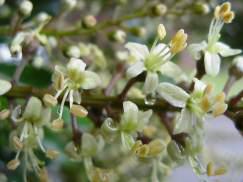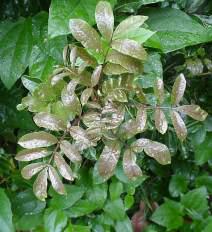Bersama lucens
Bersama lucens (Hochst.) Szyszyl.
Family: Melianthaceae
Common names: glossy white ash (Eng.); blinkblaarwitessenhout (Afr.); isindiyandiya (Xhosa); undiyaza (Zulu)
SA Tree No: 439
Introduction
Bersama lucens is not a common garden plant, rather a specialist specimen that still needs to be promoted in the garden fraternity.

Description
Description
Bersama lucens is a small to medium-sized tree, of 3 to 10 m high. The leaves are compound, shiny, leathery, thick and dark green; they are divided into 2-4 pairs of leaflets and a terminal leaflet with a short stalk. The midrib is yellow and the veins are conspicuous. The margins are wavy and entire. The flowers are small, greenish white, on slender stalks, in long, narrow heads. The tree flowers during summer, from September to May. The fruits are dull green, velvety, wrinkled, woody capsules of up to 20 mm in diameter. The capsule has 4 valves, with scarlet seeds half covered in a fleshy, yellowish aril.

Conservation Status
Status
Bersama lucens is not threatened.
Distribution and habitat
Distribution description
Bersama lucens occurs from the northeastern Cape to KwaZulu-Natal, Swaziland, eastern Gauteng and southern Mozambique. It is found growing in a variety of habitats ranging from swamps, coastal forests, high inland forests of the interior, forest margins, in kloofs and in dune bush. It is found from sea level to an altitude of about 1200 m.
Derivation of name and historical aspects
History
The genus Bersama is recognized by its dense, heavy foliage with beautiful brown new growth. The genus name Bersama refers to the Ethiopian name for this genus. The specific epithet lucens is the Latin word for glossy, which refers to the leaf surface. There are seven species of Bersama in southern Africa.

Ecology
Ecology
The fruits ripen from late summer and are eaten by Vervet monkeys and birds.
Uses
Use
Bersama lucens is a handsome evergreen tree suitable for small gardens. The Zulus use the bark as medicine to relieve menstrual pain and to treat cases of impotency and barrenness. The leaves and the roots have been reported to have caused death. This tree is also regarded as a magical protector against evil spirits.
Growing Bersama lucens
Grow
Bersama lucens is grown from seeds. Sow seeds in spring or summer, in a well-drained, well-aerated growing medium. Treat the seeds with fungicide before sowing to prevent damping off. Sprinkle the treated seeds on the seed tray and cover with river sand or fine bark. Water the tray and put it in a warm position. Germination will take 3 to 4 weeks. Prick out the seedlings and pot them when they have two pairs of compound leaves. Feed seedlings with organic fertilizer.
This is a decorative tree when in flower and even in fruit. It makes a nice specimen tree in your garden. It suits small gardens very well as it does not grow very big. It is a relatively slow grower.
References
- Coates Palgrave, M. 2002. Keith Coates Palgrave Trees of southern Africa, edn 3. Struik, Cape Town.
- Leistner, O.A. (ed.). 2000. Seed plants of southern Africa : families and genera Strelitzia 10. National Botanical Institute, Pretoria.
- Pooley, E. 1993. The complete field guide to trees of Natal, Zululand and Transkei. Natal Flora Publication Trust, Durban.
- Schmidt, E., Lotter, M. & McCleland, W. 2002. Trees and shrubs of Mpumalanga and the Kruger National Park. Jacana, Johannesburg.
- Van Wyk, A.E. & Van Wyk, P. 1997. Field guide to trees of southern Africa. Struik, Cape Town.
Credits
Giles Mbambezeli
Kirstenbosch National Botanical Garden
July 2007
Plant Attributes:
Plant Type: Tree
SA Distribution: Eastern Cape, KwaZulu-Natal, Mpumalanga
Soil type: Sandy, Loam
Flowering season: Spring, Early Summer, Late Summer, Autumn
PH: Acid, Neutral
Flower colour: White, Cream
Aspect: Full Sun, Morning Sun (Semi Shade), Afternoon Sun (Semi Shade)
Gardening skill: Average
Special Features:
Horticultural zones










Rate this article
Article well written and informative
Rate this plant
Is this an interesting plant?
Login to add your Comment
Back to topNot registered yet? Click here to register.